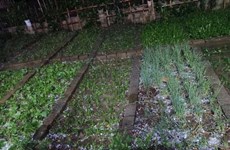Forestry effective in coastal erosion control
Vietnam has been recognised by Australia and Germany for its
success in tree planting in wetlands in Kien Giang province, for
coastline erosion control and sea-dyke protection.
Vietnam has been recognised by Australia and Germany for its
success in tree planting in wetlands in Kien Giang province, for
coastline erosion control and sea-dyke protection.
Sharon Brown, chief consultant from the German Technical Cooperation, quoted the Queensland University of Australia as saying that the project in Vam Ray hamlet, Hon Dat district, was one of very few coastal protection success stories in the world.
The project helped plant cajuput, a tree of high salinity resistance and reproductive capacity, on 3.36 ha of coastal land along 1.5 km of sea dyke from 2008 to 2011.
With financial assistance from the Australian Agency for International Development (AUSAID) and technical assistance from German Technical Cooperation (GIZ), the project successfully utilised locally available saplings and villagers’ experience in coastline erosion control, keeping project costs at a very low level.
Project technician Nguyen Tan Phong said that in the past the hamlet had tested a number of models for erosion control, such as building concrete dykes, with investments up to 30 billion VND (roughly 1.5 million USD) per km. However, time passed and dykes broke.
A villager named Tu Anh said Vam Ray was badly affected by coastline erosion in Kien Giang province.
Lam Thi Nga, who has suffered saline evasion and land erosion in the village for 25 years, said her family had more than once suffered property damage as dykes were broken and sea tides swept away her apple orchard and shrimp and fish ponds.
Since wetland forests were planted, salinity had been prevented, the soil was rich with alluvium and the sea embankment had not eroded, Nga said.
She said her family managed to grow a sugarcane garden last year which earned her some 71 million VND. Early this year, Nga invested in three more fish ponds with credit from the local women’s union.
The project’s success encouraged GIZ to expand the model to other locations in Vietnam and other countries in Southeast Asia such as Laos , Cambodia , Thailand and Indonesia , countries also hit by land erosion and salinity.
The success also served as a foundation for the Australian and German governments to allocate aid of more than 38 million USD for climate change adaptation and an ecosystems programme for the Mekong Delta. The aid, signed in Kien Giang province in early June, would benefit six provinces in the five years up to 2016.
Kien Giang had 205 km of coastline, the longest in the Mekong Delta, and boasted the largest biosphere zone in Southeast Asia .
Under a recent survey conducted by GIZ, 33 percent of the provincial coastline had suffered erosion and another 59 percent of coastline was threatened with a similar fate. Eleven kilometres of dykes had been destroyed by sea tides./.
Sharon Brown, chief consultant from the German Technical Cooperation, quoted the Queensland University of Australia as saying that the project in Vam Ray hamlet, Hon Dat district, was one of very few coastal protection success stories in the world.
The project helped plant cajuput, a tree of high salinity resistance and reproductive capacity, on 3.36 ha of coastal land along 1.5 km of sea dyke from 2008 to 2011.
With financial assistance from the Australian Agency for International Development (AUSAID) and technical assistance from German Technical Cooperation (GIZ), the project successfully utilised locally available saplings and villagers’ experience in coastline erosion control, keeping project costs at a very low level.
Project technician Nguyen Tan Phong said that in the past the hamlet had tested a number of models for erosion control, such as building concrete dykes, with investments up to 30 billion VND (roughly 1.5 million USD) per km. However, time passed and dykes broke.
A villager named Tu Anh said Vam Ray was badly affected by coastline erosion in Kien Giang province.
Lam Thi Nga, who has suffered saline evasion and land erosion in the village for 25 years, said her family had more than once suffered property damage as dykes were broken and sea tides swept away her apple orchard and shrimp and fish ponds.
Since wetland forests were planted, salinity had been prevented, the soil was rich with alluvium and the sea embankment had not eroded, Nga said.
She said her family managed to grow a sugarcane garden last year which earned her some 71 million VND. Early this year, Nga invested in three more fish ponds with credit from the local women’s union.
The project’s success encouraged GIZ to expand the model to other locations in Vietnam and other countries in Southeast Asia such as Laos , Cambodia , Thailand and Indonesia , countries also hit by land erosion and salinity.
The success also served as a foundation for the Australian and German governments to allocate aid of more than 38 million USD for climate change adaptation and an ecosystems programme for the Mekong Delta. The aid, signed in Kien Giang province in early June, would benefit six provinces in the five years up to 2016.
Kien Giang had 205 km of coastline, the longest in the Mekong Delta, and boasted the largest biosphere zone in Southeast Asia .
Under a recent survey conducted by GIZ, 33 percent of the provincial coastline had suffered erosion and another 59 percent of coastline was threatened with a similar fate. Eleven kilometres of dykes had been destroyed by sea tides./.












